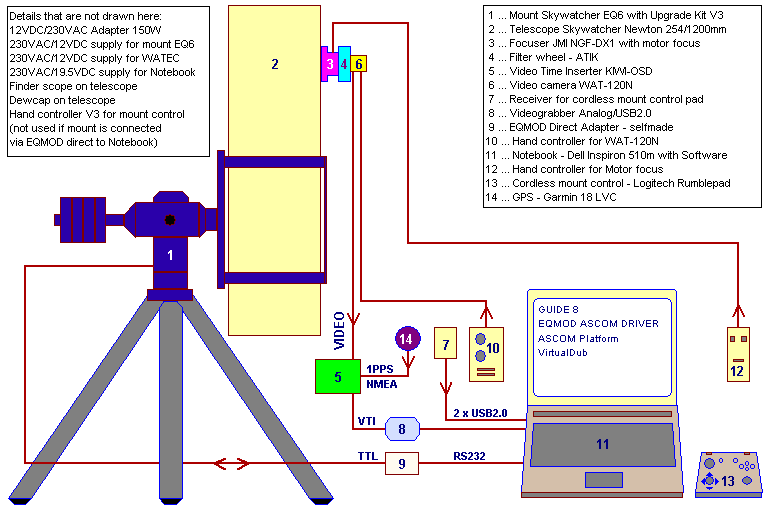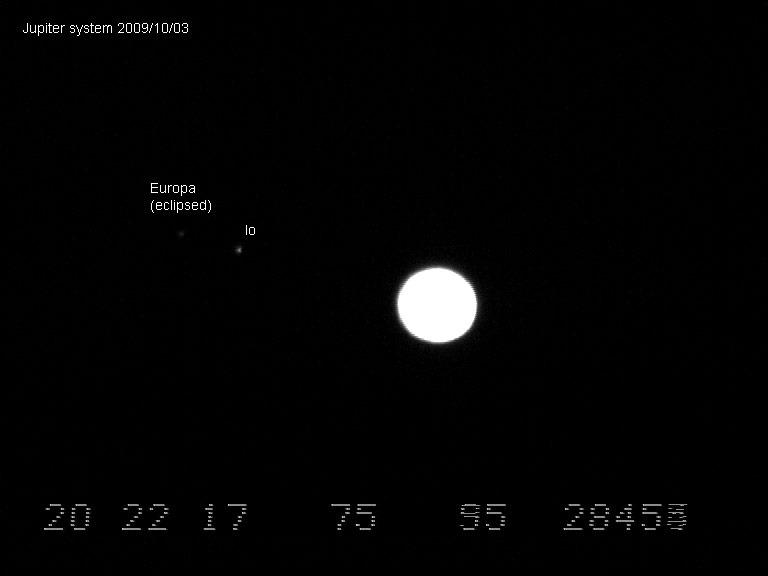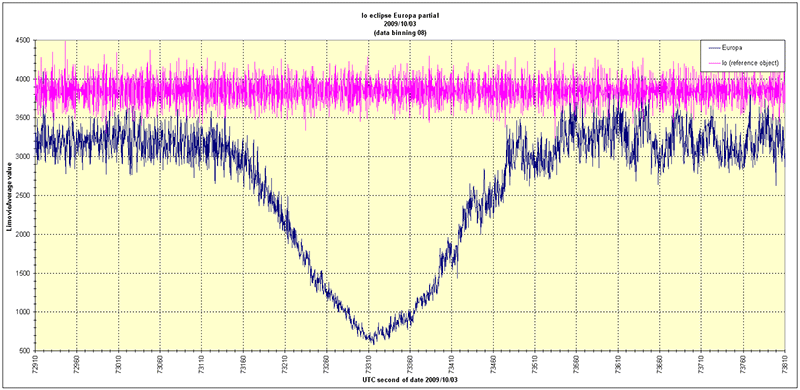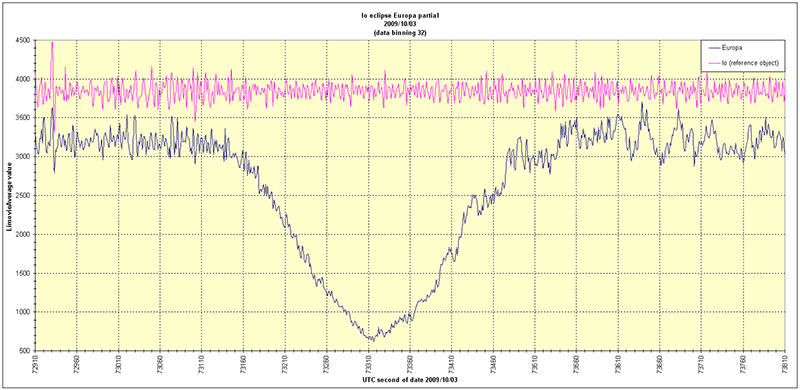| Overview - all events | Frameless version of this page |
The prediction of the partial eclipse
Year M D h m s Event Type Ph Dur dMag %Ill Sep PA MinD h m s h m s h m s h m s h m s h m s h m s 2009 10 3 20 22 16 (I) ecl (II) P 457 1.4 28.5 151.7 71 0.277 | 20 18 27 20 19 45 20 22 16 20 24 47 20 26 5

Data and diagrams created with Occult 4 from Dave Herald
Jupiter system - 2009/10/03
Starmap created with Guide 8 from Bill J Gray.
The setup for eclipse recording

CCIR (PAL) full size video image 768x576
Limovie settings
MUTUAL ECLIPSE - REPORT
MUTUAL ECLIPSE - REPORT
EAON & IOTA-ES
EUROPEAN ASTEROIDAL OCCULTATION NETWORK
INTERNATIONAL OCCULTATION TIMING ASSOCIATION EUROPEAN SECTION
1.DATE: 2009/10/03
Event: Jupiter system 1E2; Io (I) eclipsed Europa (II)
2.OBSERVER:
Name: Gerhard Dangl
Phone: ++43-(0)2842-53908
Address: AUSTRIA, A-3830, Nonndorf 12
E-mail: gerhard@dangl.at
3.OBSERVING STATION:
Nearest city: Waidhofen/Thaya
Latitude: N 48 47 13.5 (WGS84)
Longitude: E 15 14 06.3 (WGS84)
Altitude: 594m (WGS84)
550m (MSL)
Single/Multiple: Single
4.TIMING OF EVENTS:
Type of event:
"S"tart observation; "I"nterrupt-"s"tart; "D"isappearance;
"B"link; "F"lash; "E"nd observation; "I"nterrupt-"e"nd;
"R"eappearance; "O"ther (specify)
Recording time HH:MM:SS UTC
S: 20:15:07
O: 20:21:56.0 +/- 0.1s Eclispe maximum time derived from data with 8 measurement points binning.
O: 20:21:56.0 +/- 0.3s Eclispe maximum time derived from data with 16 measurement points binning.
O: 20:21:57.3 +/- 0.8s Eclispe maximum time derived from data with 32 measurement points binning.
(see comments)
E: 20:30:12
5.TELESCOPE:
Type: Newton
Focal length: 1200mm + Powermate 2.5x = 3000mm effective focal length
Aperture: 254 mm
Magnification: video/primary focus/FOV 7.3'x 5.5' (768x576, 0.57"x0.57" per pixel)
Mount: Equatorial
Motor drive: Yes
6.TIMING & RECORDING:
Timekeeping: GPS 1PPS Garmin 18x LVC + KIWI-OSD
Sensor/Camera: WAT-120N, CCIR, 1/2" Sony CCD-Sensor ICX419ALL, GAMMA=OFF (linear)
Mode of recording: It=40ms (25 Img/s), Video CCIR, AVI, YUY2, Huffyuv,
Device of recording: TIS DFG/USB2-lt Videograbber USB2.0, Notebook Harddisk
Time insertion: KIWI-OSD
7.OBSERVING CONDITIONS:
Atmospheric transparency: bad (thin clouds moving)
Wind: No
Object image stability: fair
Temperature: 278 Kelvin (+05 deg Celsius)
8.ADDITIONAL COMMENTS:
Object height above local horizon at recording start: 24 deg
Object height above local horizon at recording end: 23 deg
Only Clear glass filter (Astronomik) for CCD protection was used.
Video evaluation accomplished with VirtualDub1.8.6, AviSynth2.5,
Limovie0.9.29b, LimovieAverage 1.2.0.0 and Excel
Eclipse maximum calculation with software Peranso 2.31 using Kwee-van Woerden method
3-D Position and timing
Garmin GPS18x LVC
Receiving 08 satellites
Horizontal Dilution of Precision 1.1
Geoidal separation 44.5m (Altitude 549.7MSL + 44.5 = 594.2m in WGS84 datum)
Gerhard Dangl
gerhard@dangl.at
www.dangl.at/
The evaluation of the measurement data
The evaluation of the measurement data from recorded video was done with the software packages below:
VirtualDub
Limovie
Avisynth
LimovieAverage
Help text, using LimovieAverage with mutual events
Video, measurement data and results in csv and Excel data format of 1E2 on 2009/10/03 at 20:22 UTC
Time lapse video 50x with simulation overlay - MPEG4 (2.89 MB)
CSV file, binning 8 data points (169 KB)
Excel file, binning 8 data points (852 KB)
CSV file, binning 16 data points (85 KB)
Excel file, binning 16 data points (630 KB)
CSV file, binning 32 data points (43 KB)
Excel file, binning 32 data points (486 KB)
The diagrams in an overview
Diagram binning 8 data points - click for full size |
|
Diagram binning 16 data points - click for full size |
|
Diagram binning 32 data points - click for full size |
Ovtober 12, 2009 |
|
Site Home |